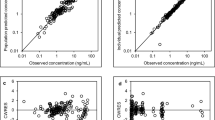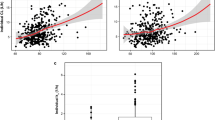Abstract
Background
Venetoclax is a selective B-cell lymphoma-2 (BCL-2) inhibitor approved for use as monotherapy or with rituximab in patients with chronic lymphocytic leukemia (CLL). The objectives of the current analysis of observed data from adult patients randomized to venetoclax–rituximab in the phase III MURANO study were to characterize venetoclax pharmacokinetics (PKs) using a Bayesian approach, evaluate whether a previously developed population PK model for venetoclax can describe the PKs of venetoclax when administered with rituximab, and to determine post hoc estimates of PK parameters for the exposure–response analysis.
Methods
Parameter estimates and uncertainty estimated by a population PK model were used as priors. Additional covariate effects (CLL risk status, geographic region, and 17p deletion [del(17p)] status) were added to the model. The updated model was used to describe venetoclax PKs after repeated dosing in combination with rituximab, and to determine post hoc estimates of PK parameters for exposure–response analysis.
Results
The PK analysis included 600 quantifiable venetoclax PK samples from 182 patients in the MURANO study. Model evaluation using standard diagnostic plots, visual predictive checks, and normalized prediction distribution error plots indicated no model deficiencies. There was no significant relationship between venetoclax apparent clearance (CL/F) and bodyweight, age, sex, mild and moderate hepatic and renal impairment, or coadministration of weak cytochrome P450 3A inhibitors. The chromosomal abnormality del(17p) and CLL risk status had no apparent effect on the PKs of venetoclax. A minimal increase in venetoclax CL/F (approximately 7%) was observed after coadministration with rituximab. CL/F was 30% lower in patients from Central and Eastern Europe (n = 60) or Asia (n = 4) compared with other regions (95% confidence interval [CI] 21–39%). Apparent central volume of distribution was 30% lower (95% CI 22–38%) in females (n = 56) compared with males (n = 126). No clinically significant impact of region or sex was observed on key safety and efficacy outcomes.
Conclusions
The Bayesian model successfully characterized venetoclax PKs over time and confirmed key covariates affecting PKs in the MURANO study. The model was deemed appropriate for further use in simulations and for generating individual patient PK parameters for subsequent exposure–response evaluation.





Similar content being viewed by others
References
Souers AJ, Leverson JD, Boghaert ER, Ackler SL, Catron ND, Chen J, et al. ABT-199, a potent and selective BCL-2 inhibitor, achieves antitumor activity while sparing platelets. Nat Med. 2013;19:202–8.
Deeks ED. Venetoclax: first global approval. Drugs. 2016;76:979–87.
Highlights of prescribing information. VENCLEXTA™ (venetoclax) tablets, for oral use. Initial US Approval: 2016. Revised: June 2018. North Chicago, IL: Abbvie Inc.
Agarwal SK, Hu B, Chien D, Wong SL, Salem AH. Evaluation of rifampin’s transporter inhibitory and CYP3A inductive effects on the pharmacokinetics of venetoclax, a BCL-2 inhibitor: results of a single- and multiple-dose study. J Clin Pharmacol. 2016;56:1335–43.
Freise KJ, Jones AK, Eckert D, Mensing S, Wong SL, Humerickhouse RA, et al. Impact of venetoclax exposure on clinical efficacy and safety in patients with relapsed or refractory chronic lymphocytic leukemia. Clin Pharmacokinet. 2017;56:515–23.
Jones AK, Freise KJ, Agarwal SK, Humerickhouse RA, Wong SL, Salem AH. Clinical predictors of venetoclax pharmacokinetics in chronic lymphocytic leukemia and non-Hodgkin’s lymphoma patients: a pooled population pharmacokinetic analysis. AAPS J. 2016;18:1192–202.
Salem AH, Hu B, Freise KJ, Agarwal SK, Sidhu DS, Wong SL. Evaluation of the pharmacokinetic interaction between venetoclax, a selective BCL-2 inhibitor, and warfarin in healthy volunteers. Clin Drug Investig. 2017;37:303–9.
Salem AH, Agarwal SK, Dunbar M, Enschede SL, Humerickhouse RA, Wong SL. Pharmacokinetics of venetoclax, a novel BCL-2 inhibitor, in patients with relapsed or refractory chronic lymphocytic leukemia or non-Hodgkin lymphoma. J Clin Pharmacol. 2017;57:484–92.
Agarwal SK, DiNardo CD, Potluri J, Dunbar M, Kantarjian HM, Humerickhouse RA, et al. Management of venetoclax-posaconazole interaction in acute myeloid leukemia patients: evaluation of dose adjustments. Clin Ther. 2017;39:359–67.
Freise KJ, Hu B, Salem AH. Impact of ritonavir dose and schedule on CYP3A inhibition and venetoclax clinical pharmacokinetics. Eur J Clin Pharmacol. 2018;74:413–21.
Agarwal SK, Salem AH, Danilov AV, Hu B, Puvvada S, Guttierez M, et al. Effect of ketoconazole, a strong CYP3A inhibitor, on the pharmacokinetics of venetoclax, a BCL-2 inhibitor, in patients with non-Hodgkin lymphoma. Br J Clin Pharmacol. 2017;83:846–54.
Freise KJ, Shebley M, Salem AH. Quantitative prediction of the effect of CYP3A inhibitors and inducers on venetoclax pharmacokinetics using a physiologically based pharmacokinetic model. J Clin Pharmacol. 2017;57:796–804.
Liu H, Michmerhuizen MJ, Lao Y, Wan K, Salem AH, Sawicki J, et al. Metabolism and disposition of a novel B-cell lymphoma-2 inhibitor venetoclax in humans and characterization of its unusual metabolites. Drug Metab Dispos. 2017;45:294–305.
Center for Drug Evaluation and Research. Application number: 208573Orig1s000. Clinical pharmacology and biopharmaceutics review(s). NDA 208573 Venetoclax. Reference ID: 3901940. 2015. https://www.accessdata.fda.gov/drugsatfda_docs/nda/2016/208573Orig1s000ClinPharmR.pdf. Accessed 6 Nov 2018.
Seymour JF, Kipps TJ, Eichhorst B, Hillmen P, D’Rozario J, Assouline S, et al. Venetoclax-rituximab in relapsed or refractory chronic lymphocytic leukemia. N Engl J Med. 2018;378:1107–20.
International Conference on Harmonisation of Technical Requirements for Registration of Pharmaceuticals for Human Use (ICH) adopts consolidated guideline on good clinical practice in the conduct of clinical trials on medicinal products for human use. Int Dig Health Legis. 1997;48:231–4.
World Medical Association. World Medical Association Declaration of Helsinki: ethical principles for medical research involving human subjects. JAMA. 2013;310:2191–4.
Gisleskog PO, Karlsson MO, Beal SL. Use of prior information to stabilize a population data analysis. J Pharmacokinet Pharmacodyn. 2002;29:473–505.
Yano Y, Beal SL, Sheiner LB. Evaluating pharmacokinetic/pharmacodynamic models using the posterior predictive check. J Pharmacokinet Pharmacodyn. 2001;28:171–92.
Bergstrand M, Hooker AC, Wallin JE, Karlsson MO. Prediction-corrected visual predictive checks for diagnosing nonlinear mixed-effects models. AAPS J. 2011;13:143–51.
Brendel K, Comets E, Laffont C, Laveille C, Mentre F. Metrics for external model evaluation with an application to the population pharmacokinetics of gliclazide. Pharm Res. 2006;23:2036–49.
Beal S, Sheiner LB, Boeckmann A, Bauer RJ. NONMEM user’s guides (1989–2011). Ellicott City: Icon Development Solutions; 2011.
Freise KJ, Jones AK, Verdugo ME, Menon RM, Maciag PC, Salem AH. Moving beyond maximum tolerated dose for targeted oncology drugs: use of clinical utility index to optimize venetoclax dosage in multiple myeloma patients. Clin Pharmacol Ther. 2017;102:970–6.
Parikh A, Gopalakrishnan S, Freise KJ, Verdugo ME, Menon RM, Mensing S, et al. Exposure-response evaluations of venetoclax efficacy and safety in patients with non-Hodgkin lymphoma. Leuk Lymphoma. 2018;59:871–9.
Guinney J, Wang T, Laajala TD, Winner KK, Bare JC, Neto EC, et al. Prediction of overall survival for patients with metastatic castration-resistant prostate cancer: development of a prognostic model through a crowdsourced challenge with open clinical trial data. Lancet Oncol. 2017;18:132–42.
Wang B, Nichol JL, Sullivan JT. Pharmacodynamics and pharmacokinetics of AMG 531, a novel thrombopoietin receptor ligand. Clin Pharmacol Ther. 2004;76:628–38.
Kumagai Y, Fujita T, Ozaki M, Sahashi K, Ohkura M, Ohtsu T, et al. Pharmacodynamics and pharmacokinetics of AMG 531, a thrombopoiesis-stimulating peptibody, in healthy Japanese subjects: a randomized, placebo-controlled study. J Clin Pharmacol. 2007;47:1489–97.
Freise KJ, Jones AK, Menon RM, Verdugo ME, Humerickhouse RA, Awni WM, et al. Relationship between venetoclax exposure, rituximab coadministration, and progression-free survival in patients with relapsed or refractory chronic lymphocytic leukemia: demonstration of synergy. Hematol Oncol. 2017;35:679–84.
Salem AH, Dunbar M, Agarwal SK. Pharmacokinetics of venetoclax in patients with 17p deletion chronic lymphocytic leukemia. Anticancer Drugs. 2017;28:911–4.
Deng R, Gibiansky L, Lu T, Li X, Lu D, Li C, et al. Exposure-response analysis of venetoclax in combination with rituximab in patients with relapsed or refractory chronic lymphocytic leukemia: phase 3 MURANO study. American College of Clinical Pharmacology Conference; 23–25 Sep 2018: Bethesda, MD
Weisstein EW. Bayesian analysis. From MathWorld – A Wolfram Web Resource. http://mathworld.wolfram.com/BayesianAnalysis.html. Accessed 19 Dec 2018.
van de Schoot R, Kaplan D, Denissen J, Asendorpf JB, Neyer FJ, van Aken MAG. A gentle introduction to bayesian analysis: applications to developmental research. Child Dev. 2014;85:842–60.
Bolstad WM, Curran JM. Introduction to Bayesian statistics. 3rd ed. Hoboken: Wiley; 2017.
Acknowledgements
Special thanks to the patients and their families, investigators, study coordinators, and support staff, and the MURANO study team members. The authors also thank Dr. Mehrdad Mobasher for his valuable contributions to the manuscript. Venetoclax is being developed in collaboration between Genentech, Inc. and AbbVie. Genentech and AbbVie provided financial support for the study and participated in the design, study conduct, analysis, and interpretation of data, as well as the writing, review, and approval of the manuscript. Third-party medical writing assistance was provided by Christopher Dunn and Andrew Sutton of Gardiner-Caldwell Communications, and was funded by F. Hoffmann-La Roche Ltd.
Author information
Authors and Affiliations
Corresponding author
Ethics declarations
Funding
Genentech and AbbVie provided financial support for this study.
Conflict of interest
Rong Deng, Tong Lu, Dan Lu, Chunze Li, Sandhya Girish, Jue Wang, and Dale Miles are employees of Genentech and have equity in Genentech/F. Hoffmann-La Roche Ltd. Leonid Gibiansky received consultancy fees from Genentech. Priya Agarwal and Xiaobin Li are employees of Genentech. Hao Ding and Smita Kshirsagar are paid contractors of Genentech. Michelle Boyer is an employee of F. Hoffmann-La Roche Ltd and has equity in the company. Kathryn Humphrey is an employee of F. Hoffmann-La Roche Ltd. Kevin J. Freise and Ahmed Hamed Salem are employees of AbbVie and have equity in the company. John F. Seymour received grants from AbbVie, Celgene, Janssen, and F. Hoffmann-La Roche Ltd; consultancy fees from AbbVie, Acerta, Celgene, Janssen, F. Hoffmann-La Roche Ltd, and Takeda; travel support from AbbVie; advisory board fees from Celgene; lecture/speakers’ bureau fees from AbbVie and F. Hoffmann-La Roche Ltd; and expert testimony fees from F. Hoffmann-La Roche Ltd. Arnon P. Kater received grants from F. Hoffmann-La Roche Ltd, Genentech, and AbbVie; consultancy fees from AbbVie; travel support from F. Hoffmann-La Roche Ltd; and lecture/speakers’ bureau fees from AbbVie.
Ethical approval
All procedures performed in the MURANO study were in accordance with the ethical standards of the institutional and/or national research committee and with the 1964 Helsinki declaration and its later amendments or comparable ethical standards.
Informed consent
Informed consent was obtained from all individual participants included in the MURANO study.
Electronic supplementary material
Below is the link to the electronic supplementary material.
Rights and permissions
About this article
Cite this article
Deng, R., Gibiansky, L., Lu, T. et al. Bayesian Population Model of the Pharmacokinetics of Venetoclax in Combination with Rituximab in Patients with Relapsed/Refractory Chronic Lymphocytic Leukemia: Results from the Phase III MURANO Study. Clin Pharmacokinet 58, 1621–1634 (2019). https://doi.org/10.1007/s40262-019-00788-8
Published:
Issue Date:
DOI: https://doi.org/10.1007/s40262-019-00788-8




